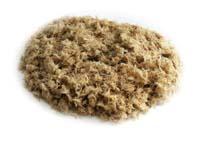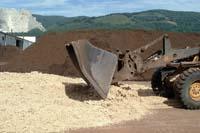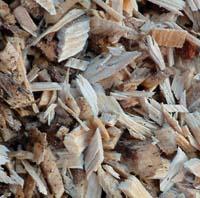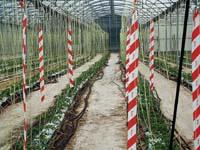Pine chips in intensive cultivation
2006/07/01 Kortabitarte Egiguren, Irati - Elhuyar Zientzia Iturria: Elhuyar aldizkaria

The new organic substrate that can be used in intensive crops has been developed by a team of researchers from the Public University of Navarre, led by Julio Muro Erscrub, together with the Navarra company Aralur de Ziordia. The product has already been patented and marketed.
These types of substrates are used in intensive crops that require containers for crop cultivation, especially in greenhouse crops. Intensive cultivation, in general, is oriented to commercial production. Small or medium flat plots with important technical means are used. Greenhouses and crops under plastic are frequent in fertile soils with extreme climates, very cold or very dry.
When plants are worked in small containers, the limiting element is the oxygen that reaches the roots. That is why a substrate more porous than the soil is needed. Normal soil has 50% air. This new substrate is 90%. Improves ventilation of the plant. This substrate facilitates crop growth and offers better results.
The name of the product developed is Fibralur, derived from pine chips. These chips are broken down through an industrial process. It is the same process used for the production of paper, using the same devices as those used in the manufacture of paper for the shredding of wood, but obtaining in this case thicker and longer fibers (1-10 mm).
In fact, the wood fibres for the production of paper suffer two or three times the striping process, while for obtaining the Fibralur product a single stripping process is sufficient. In this process of scratching the pine skin is cleaned with water at 90-115 ° C. This leaves cellulose in an almost pure state, without phytotoxic products and ready for use in agricultural crops.
Recyclable and cheaper


With the new material available, researchers have proven its effectiveness, among others, in mushrooms, in some hydroponic crops - plant crops in artificial substrates - and, to a lesser extent, in orchard and forest nurseries. It has been proven to be the ideal substrate to compete with the currently existing substrates in the market, especially in mushrooms and hydroponic crops. In these cases only this substrate can be used. In the seminars it must be mixed with peat.
Peat is the first soil at the garden level due to its technical characteristics. Highly appreciated as absorbent and as fertilizer. But most are imported from cold places in northern Europe (Finland, Sweden, Norway, etc.). ). This, logically, greatly increases the product. In this sense, the product developed by the team of researchers of the Public University of Navarra and the company Aralur has the advantage of being a local product, which is produced there and therefore is more economical.
In addition, inorganic substrates such as perlite and rock wool or rock wool are used in hydroponic production. Once these substrates are used they will be deposited in landfills or landfills. Wood fiber, like peat, is a recyclable organic substrate, that is, once used it can be poured into the soil as if we were to throw manure into the garden.





